|
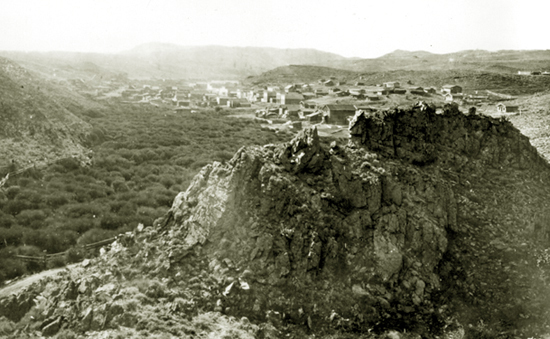
South Pass City, 1871. Photo by William Henry Jackson.
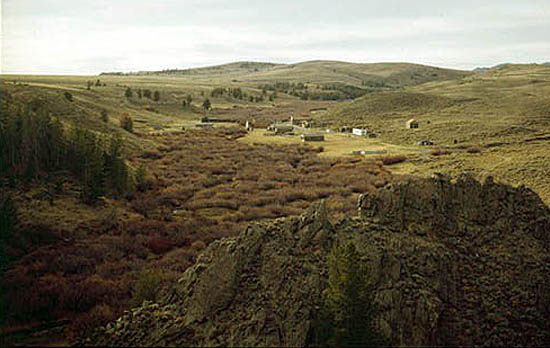
South Pass City, taken from approximately the same location as the
William Henry Jackson photo above.
Ghost towns are frequently associated with played out mines. Such is South Pass City,
perhaps, the most famous of Wyoming's ghost towns.
For discussion of the discovery of South Pass see Lander.
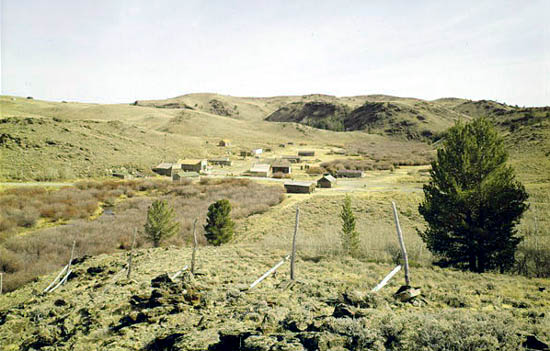
South Pass City.
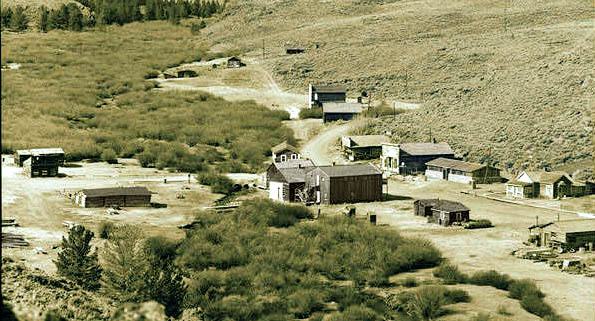
South Pass City.
Gold was allegedly discovered in the South Pass area in 1842 by a trapper working for the American
Fur Company. According to an article in the Sweetwater Miner, March 24, 1869, the trapper
was killed by Indians before he could organize mining activities. A "gold rush" did not occur until July, 1867 when newspaper accounts picked up the discovery of
the Carissa Lode. The Chicago Times, under an Omaha dateline, reported on July 13:
Salt Lake papers of July 1, received here, give accounts of rich gold discoveries in the mines of that territory. Three men brought in 40 ounces of quartz
dust, which assayed over $700. these mines are located in
Green river country, 200 miles distant from Salt Lake.
The lode, along Willow Creek, had been discovered in 1865 by Tom Ryan of the Nevada Volunteers.
By the
time Ryan could report his discovery, a company under H. S. Reedall had registered the claim.
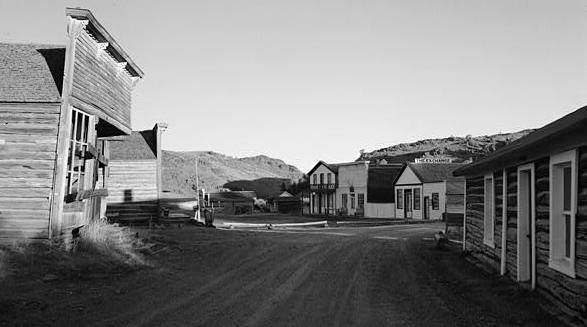
Modern view of South Pass City.
On the left in the above view is the Carissa Saloon. The far corner of the saloon was caved in when in
1960 a motor grader ran into the building. The saloon was subsequently repaired and reopened in 1977. At one time,
next door to the Carissa Saloon was the White Swan, a sporting parlor. Some of the
"cribs" were located on the hill behind the White Swan.
The Carissa Saloon was originally constructed about 1890. The next building on the
left side of the street is the Sherlock Store and post office constructed in 1898. The post office
closed in 1948. The three buildings at the end of the street from the left are
the Sherlock Hotel (with the balcony), the Grecian Bend Saloon (with the false front), the Exchange Bank (the gabled one-story building), and the Recorder's office
(the shed roofed building attached to the bank), all of which have
been restored in the above photo. For older unrestored view, see next photo.
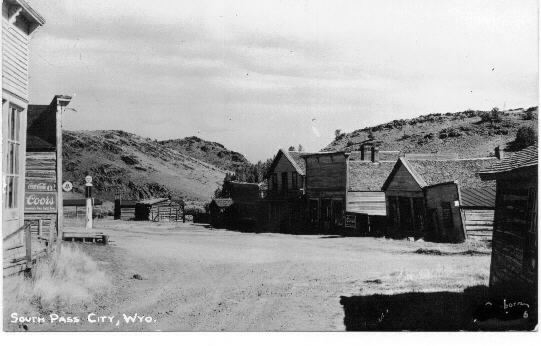
View of Sherlock Store, hotel, saloon, bank, and recorder's office, South Pass City, undated.
The hotel was originally constructed in 1868 as the Idaho House. In 1873 it was
sold to Janet Sherlock. The "Recorder's Office" acted as the original seat of
government for Carter County and later Sweetwater County. The Exchange Bank was opened
in 1868 by John W. Iliff, the cattle king, and Amos Steck (1822-1908), a former mayor of
Denver. The bank closed in 1870 and in 1890 was converted to a saloon.
The recorder's office was connected to the saloon and used as
a gambling parlor. Steck returned to Denver where he bacame one of the
leading lawyers in Colorado, representing, among others, Augusta Pierce Tabor, in the
scandalous divorce from Horace Tabor, the silver king, when Tabor became smitten with
the former Mrs. Harvey Doe (Baby Doe Tabor). Augusta built her $300,000 share of
Tabor's fortune up to $1,500,000.00 by the time of her death. Among her investments was an
interest in the hotel in which Horace resided. In contrast, Horace Tabor, at one time the fifth wealthiest
person in the United States, lost his
fortune in the Panic of 1892 and died in poverty. He died allegedly advising Baby Doe to hold on to
the Matchless Mine in Leadville. Baby Doe held on. She froze to death in her
newspaper lined cabin on the property.
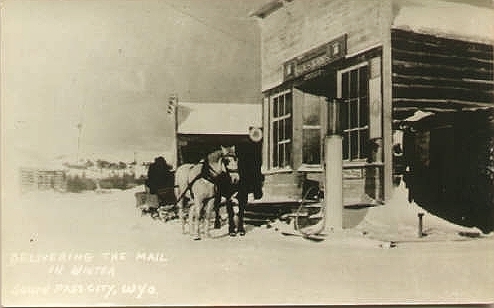
Sherlock Store, South Pass City, undated.
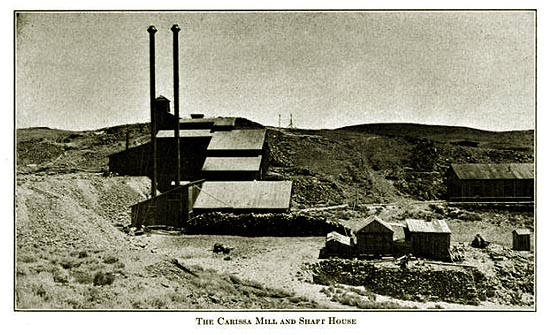
Carissa Mine, South Pass City, 1911.
The Carissa Mine is the chief mine at South Pass City. In 1867 Sioux Indians attacked the miners. The miners fled, but returned
and by 1868 had mined some $15,000.00 of gold. With the rush, optimism, if not the town, bloomed.
The Indians continued to be a problem. In May 1868, Indians in a raid carried off an estimated
100 horses and mules. Although the miners were well armed, they were now short on mounts and were unable
to successfully pursue the raiders. In order to bring in mining supplies and equipment, the herds of horses
and mules were replenished. A month later, the Indians returned and again took the stock as well as
general merchandise. They killed four men. In August, Indians attacked an ox train bringing in supplies for
one of the new mercantile establishments. The two freighters were wounded but suceeded in driving off the
Indians. The more severerly wounded driver was wrapped in blankets and left beneath a wagon while the other named Hirst went for help.
Upon his return with William Rose, William Tweed and another man, they found that the driver dead and the merchandise gone.
Rose was a newly appointed County Commissioner and a part owner of the Empire State Mine. Tweed, a Yorkshireman, operated a butcher shop in
South Pass City. Later Tweed brought the first herd of sheep into the Lander Valley. The party
attempted to return to South Pass City but were attacked by the Indians near the Ice Slough. The four took refuge in a willow grove.
Rose had a fast horse and determined to ride for help. In the words of Professor C. G. Coutant,
The History of Wyoming, Chaplin, Spofford & Mathison Printers, Laramie City, 1890,
"Poor Rose discovered that his great confidence in his racer was misplaced, and
like many another, found that he had staked his all on the wrong horse."
Rose was balding. Thus, the Indians were able to take only one side side scalp. They also
took one ear and the sinews from his arms and back, apparently to use to tie arrow heads and as bow string in the
same manner as they would use the sinew from deer. Jim Clayton in his Journal commented,
"In fact poor Bill seems to have been pretty much used up." Rose's demise permitted the
others to escape.
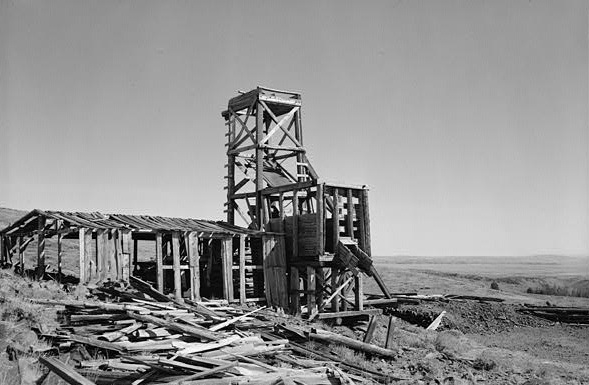
Head Frame, Empire State Mine (B & H Mine) near South Pass City.
Photo courtesy Library of Congress.
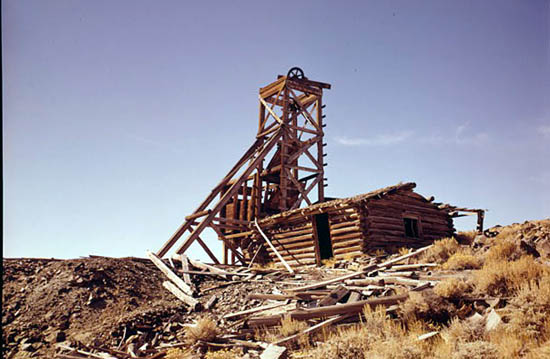
Cabin and Shaft House, Empire State Mine (B & H Mine) near South Pass City.
Music this page:
Oh, My Darling Clementine
I.
In the centre of a golden valley,
Dwelt a maiden all divine,
A pretty creature, a miner's daughter,
And her name was Clementine.
Refrain
Oh my darling, oh my darling,
My darling Clementine,
You are lost for me forever,
Dreadful sorry, Clementine.
II.
Her noble father was the forman
Of ev'ry valued mine,
And ev'ry miner and ranchman
Was a brother to Clementine.
III.
The foreman miner, an old forty niner,
In dreams and thoughts sublime,
Lived in comfort with his daughter,
His pretty child Clementine.
IV.
When far away, he would often pray
That in his sunny clime
No harm might overtake her,
His favorite nugget, Clementine.
V.
When the day was done and the setting sun
Its rays they ceased to shine,
Homeward came the brawney miner
To caress his Clementine.
VI.
None was nearer, none was dearer,
Since the days of forty-nine
When, in youth, he had another
Who was then his Clementine.
VII.
She led her ducks down to the river,
The weather it was fine,
Stubbed her toe against a sliver,
Fell into the raging brine.
VIII.
He heard her calling: father,
Her voice was like a chime,
But alas he was no swimmer,
So he lost his Clementine
Next page: South Pass City continued, Women's Sufferage.
|